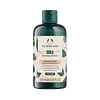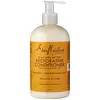What's inside
What's inside
 Key Ingredients
Key Ingredients

 Benefits
Benefits

 Concerns
Concerns

 Ingredients Side-by-side
Ingredients Side-by-side

Water
Skin ConditioningCetearyl Alcohol
EmollientCetrimonium Chloride
AntimicrobialButyrospermum Parkii Butter
Skin ConditioningLecithin
EmollientCocos Nucifera Oil
MaskingPanthenol
Skin ConditioningPhenoxyethanol
PreservativeHydroxyethylcellulose
Emulsion StabilisingPropanediol
SolventParfum
MaskingGuar Hydroxypropyltrimonium Chloride
Skin ConditioningLinalool
PerfumingSr-Spider Polypeptide-1
Skin ProtectingCoumarin
Perfuming1,2-Hexanediol
Skin ConditioningCaprylyl Glycol
EmollientSodium Hydroxide
BufferingCitric Acid
BufferingCaramel
Cosmetic ColorantCI 19140
Cosmetic ColorantWater, Cetearyl Alcohol, Cetrimonium Chloride, Butyrospermum Parkii Butter, Lecithin, Cocos Nucifera Oil, Panthenol, Phenoxyethanol, Hydroxyethylcellulose, Propanediol, Parfum, Guar Hydroxypropyltrimonium Chloride, Linalool, Sr-Spider Polypeptide-1, Coumarin, 1,2-Hexanediol, Caprylyl Glycol, Sodium Hydroxide, Citric Acid, Caramel, CI 19140
Water
Skin ConditioningStearyl Alcohol
EmollientOlea Europaea Fruit Oil
MaskingBehentrimonium Chloride
PreservativeCetyl Alcohol
EmollientButyrospermum Parkii Butter
Skin ConditioningGlyceryl Caprylate
EmollientArgania Spinosa Kernel Oil
EmollientMacrocystis Pyrifera Extract
Skin ConditioningSimmondsia Chinensis Seed Oil
EmollientDaucus Carota Sativa Seed Oil
EmollientHydrolyzed Silk
HumectantHydrolyzed Soy Protein
HumectantAloe Barbadensis Leaf Juice
Skin ConditioningPanthenol
Skin ConditioningTocopheryl Acetate
AntioxidantDicaprylyl Ether
EmollientSodium Isostearoyl Lactylate
EmulsifyingSodium Benzoate
MaskingHydroxyethylcellulose
Emulsion StabilisingGlyceryl Undecylenate
EmollientParfum
MaskingWater, Stearyl Alcohol, Olea Europaea Fruit Oil, Behentrimonium Chloride, Cetyl Alcohol, Butyrospermum Parkii Butter, Glyceryl Caprylate, Argania Spinosa Kernel Oil, Macrocystis Pyrifera Extract, Simmondsia Chinensis Seed Oil, Daucus Carota Sativa Seed Oil, Hydrolyzed Silk, Hydrolyzed Soy Protein, Aloe Barbadensis Leaf Juice, Panthenol, Tocopheryl Acetate, Dicaprylyl Ether, Sodium Isostearoyl Lactylate, Sodium Benzoate, Hydroxyethylcellulose, Glyceryl Undecylenate, Parfum
Ingredients Explained
These ingredients are found in both products.
Ingredients higher up in an ingredient list are typically present in a larger amount.
This ingredient is also known as shea butter. It is an effective skin hydrator and emollient.
Emollients help soothe and soften your skin. It does this by creating a protective film on your skin. This barrier helps trap moisture and keeps your skin hydrated. Emollients may be effective at treating dry or itchy skin.
Shea butter is rich in antioxidants. Antioxidants help fight free-radicals, or molecules that may harm the body. It is also full of fatty acids including stearic acid and linoleic acid. These acids help replenish the skin and keep skin moisturized.
While Shea Butter has an SPF rating of about 3-4, it is not a sunscreen replacement.
Shea butter may not be fungal acne safe. We recommend speaking with a professional if you have any concerns.
Learn more about Butyrospermum Parkii ButterHydroxyethylcellulose is used to improve the texture of products. It is created from a chemical reaction involving ethylene oxide and alkali-cellulose. Cellulose is a sugar found in plant cell walls and help give plants structure.
This ingredient helps stabilize products by preventing ingredients from separating. It can also help thicken the texture of a product.
This ingredient can also be found in pill medicines to help our bodies digest other ingredients.
Learn more about HydroxyethylcellulosePanthenol is a common ingredient that helps hydrate and soothe the skin. It is found naturally in our skin and hair.
There are two forms of panthenol: D and L.
D-panthenol is also known as dexpanthenol. Most cosmetics use dexpanthenol or a mixture of D and L-panthenol.
Panthenol is famous due to its ability to go deeper into the skin's layers. Using this ingredient has numerous pros (and no cons):
Like hyaluronic acid, panthenol is a humectant. Humectants are able to bind and hold large amounts of water to keep skin hydrated.
This ingredient works well for wound healing. It works by increasing tissue in the wound and helps close open wounds.
Once oxidized, panthenol converts to pantothenic acid. Panthothenic acid is found in all living cells.
This ingredient is also referred to as pro-vitamin B5.
Learn more about PanthenolParfum is a catch-all term for an ingredient or more that is used to give a scent to products.
Also called "fragrance", this ingredient can be a blend of hundreds of chemicals or plant oils. This means every product with "fragrance" or "parfum" in the ingredients list is a different mixture.
For instance, Habanolide is a proprietary trade name for a specific aroma chemical. When used as a fragrance ingredient in cosmetics, most aroma chemicals fall under the broad labeling category of “FRAGRANCE” or “PARFUM” according to EU and US regulations.
The term 'parfum' or 'fragrance' is not regulated in many countries. In many cases, it is up to the brand to define this term.
For instance, many brands choose to label themselves as "fragrance-free" because they are not using synthetic fragrances. However, their products may still contain ingredients such as essential oils that are considered a fragrance by INCI standards.
One example is Calendula flower extract. Calendula is an essential oil that still imparts a scent or 'fragrance'.
Depending on the blend, the ingredients in the mixture can cause allergies and sensitivities on the skin. Some ingredients that are known EU allergens include linalool and citronellol.
Parfum can also be used to mask or cover an unpleasant scent.
The bottom line is: not all fragrances/parfum/ingredients are created equally. If you are worried about fragrances, we recommend taking a closer look at an ingredient. And of course, we always recommend speaking with a professional.
Learn more about ParfumWater. It's the most common cosmetic ingredient of all. You'll usually see it at the top of ingredient lists, meaning that it makes up the largest part of the product.
So why is it so popular? Water most often acts as a solvent - this means that it helps dissolve other ingredients into the formulation.
You'll also recognize water as that liquid we all need to stay alive. If you see this, drink a glass of water. Stay hydrated!
Learn more about Water